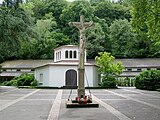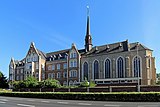|
Main cemetery monument zone
|
Beatusstrasse
location
|
1820
|
Main cemetery:
- Memorials:
- so-called Napoleon stone , veteran monument (field 5): basalt lava base with cuirassier helmet made of cast iron, 1843;
- Allied cemetery (fields 49a, 49b, 49c): memorial stones from several wars put together: antique stele with the names of the French soldiers who died in the Karthaus camp in 1870/71; Wooden cross in memory of the French and African soldiers of Emperor Napoleon III; Sandstone obelisk for the fallen 1870/71, 1885; Allied Monument or Duck Monument, obelisk on top of a hill, 1927; Russian memorial: altar-like sandstone block, in memory of prisoners of war and forced laborers from Eastern European countries, 1950; to the west above the Allied cemetery, a small chapel as a foundation for the French prisoners of war on the Carthusian monastery in the Franco-German war;
- Ehrenfriedhof 1914–1918 (field 38): the gate hall accessible via a high flight of stairs, inside panels with the names of the troops stationed in Koblenz during the First World War, the numbers of those killed and the dedication by the city; Burial field with small name plaques;
- Memorial for the victims of the air raid on Koblenz on March 12, 1918, field 8: Limestone block in the manner of a sarcophagus with relief;
- Place of honor 1939–1945 (field 12, 24a, 24 b, 24c) and memorial: former Hübeling or Hüberling battery (earth-covered casemated building from 1828 to 1830); 1954–56 redesigned as a hall of honor with a bronze angel and a listing of the Koblenz war dead, the fallen and civilian victims of the bombing ; Memorial cemetery with 1,600 ceramic plates and groups of three crosses;
- south of Grabfeld 20a, the so-called Hochkreuz des Ostens in memory of the expulsion of Germans from the eastern regions, semicircular terrace with a simple wooden cross, 1950s;
- Tombs:
- Field 1: Family Josef Rehm: galvanoplastic figure of a mourner, 1933; Heinrich Pabst († 1918): broad stele with relief; Dornbach family (Josef Dornbach † 1919) :, antique Lahn marble stele;
- Field 2: eight late baroque grave crosses from the cemetery in front of the Löhrtor; Burkhard-Grisar family, grave site at the beginning of the 20th century, monumental ring cross, side relief, edging with pointed arch posts; Karl Basses († 1916): in the form of a late baroque grave cross; Rudolf Kräber († 1897): eclectic aediculus tomb with varied decor; Grave site of the Vahlbruch family (Ernst Vahlbruch † 1911): three-dimensional angel with a wreath of flowers, galvanoplastic grids; Clemens Joseph von Solemacher († 1842): stele with torch relief; Karl Handrack († 1923): round altar with large urn; Georg Eisenbach († 1913): simple aedicula with Christ relief; Heinrich Marckworth and Joseph Wilzler († 1870): square pillow stones; Wilhelm Kurth († 1946): sarcophagus with corner acroteries and Koblenz city arms; Theophil Gassen († 1878): pinnacle crowned altar with blessing Christ;
- Field 3: Christian von Stramberg († 1868): stele with portrait medallion; Caroline Settegast († 1871): cross with cast-iron crucifix; Bernhard Clostermann († 1919): segment-arched wall with neo-classical figure reliefs; Dienz-Kühlenthal family: Classicist marble stele, 1919;
- Field 4: Ignaz Mündnich († 1868): death lamp made of light sandstone; The Maring couple: neo-baroque columned aedicula with Christ blessing by Bertel Thorvaldsen as galvanoplasty;
- Field 6: Gertrude Hubertina Drimborn († 1812), cube-shaped base with putto; Electroplating of a blessing Christ; Carl Albrecht († 1833): towering cast iron tabernacle in neo-Gothic forms, Sayner Hütte ; marble figure of a mourner on the staircase; Karl Baedeker († 1859) and family: two classicist marble steles; The Bingel family, antique marble stele with elaborate crowning, 1856; Franz Joseph Reichensperger († 1815): stump of column with urn;
- above field 8 freely erected marble sculpture of a kneeling child, late 19th century;
- Field 10: Johannes Melzenbach, († 1927): Aedicula with bronze figure of a kneeling woman;
- Field 11: Henrich family, altar-like tombstone with Pietà relief, 1913;
- Field 15: Karl Heinrich Lottner († 1897), granite stele with portrait medallion and neo-Gothic tabernacle with marble crucifix; Family Spaeter , altar-like tombstone with half-figure of an angel, 1883; Family Spaeter, crypt with Doric portico, 1910;
- Field 16: Wegeler family: cast iron, upright grave slabs for Franz Gerhard von Wegeler († 1848), Helena Bauer, b. Wegeler († 1832) and Eleonore Wegeler b. Breuning († 1847); Family Cadenbach, four lying pillow stones, u. a. Hubert Josef Cadenbach († 1867); Jakob Freiherr Raitz von Frentz († 1884): neo-baroque stele with coat of arms;
- Field 17: Johann Adolf Freiherr von Thielmann († 1824): marble slab, cast-iron riding helmet and coat of arms; Karl Gustav Julius von Griesheim († 1854) grave slab with antique helmet; Eduard Wilhelm Ludwig von Bonin († 1865), classicist stele with portrait medallion; Herbert Joseph Aldenhoven († 1864): broken column; Franz Hubert Aldenhoven family, simple marble tablet with ancient symbols; extensive grave site of the Wegeler family, Emma Wegeler († 1904): altar-like main wall and border with chain posts; The Bresgen-von Bönninghausen family, Lilli Bresgen († 1927): a semicircular structure with a life-size bronze figure composed in the slope;
- Field 19: Friedrich Karl Ortmann († 1914), block-like small architecture with pyramidal roofing and city arms; Peter Friedhofen († 1904), grave complex with a large cross and galvanoplastic crucifix, tubular frame; Maeckler family, historicist tomb with a relief from the Descent from the Cross; Adeline Jeanjour († 1951), cross with Christ relief;
- Field 20: Gieck-Marcour family, obelisks with electroplating of a mourner, 1904; Jakob Knödgen († 1907), bas-relief with a back figure of a mourner; Phil. Hillesheim family, simple aedicula, therein figure of the Virgin Mary, 1917; Family Pabst, oval, open shell limestone rotunda, therein bronze Pietà, inscribed. 1925;
- Field 20a: Family Härle-Schultheiß, broad grave field, on a sarcophagus-like block Christ with the cross, 1920 / 1930s;
- Field 21: Family Carl Mand († 1892), Ionic columns with segmented gable; Friedrich Wilhelm Hinsmann († 1903), angel scattering flowers; Anonymous, marble figure of a kneeling girl, late 19th century;
- between fields 24a and b: Lotte Weidtmann († 1920), electroplating of a kneeling mourner;
- Field 36a: Sculpture of a man, former Mayer-Alberti burial site, early 20th century;
|
 more pictures more pictures
|
 more pictures
more pictures

 more pictures
more pictures
 more pictures
more pictures
